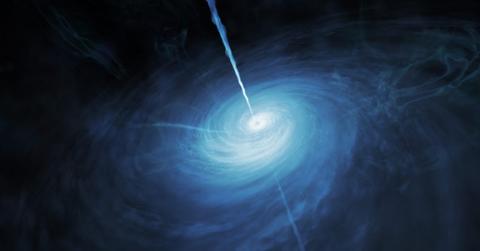Dazzling Discovery: Giant Luminous Galactic Core ‘Hiding in Plain Sight’ 500-Trillion Times Brighter Than Sun

The Hubble Space Telescope spotted this quasar in 2019.
A recent discovery in the cosmos challenges the conventional notions associated with black holes.
Dubbed Quasar J0529-4351, it stands out not for its darkness, but for its astonishing brightness. Situated over 12 billion light years away from Earth, this colossal phenomenon defies traditional expectations.
Astronomers were astounded by the sheer luminosity emanating from the distant entity. Christopher Onken of Australian National University noted that Quasar J0529-4351 "was hiding in plain sight," highlighting the deceptive nature of its brilliance.
Estimated to be "500 trillion times brighter than our sun," Quasar J0529-4351 illuminates the cosmos with unparalleled intensity.
Quasars, as described by Space.com, represent the radiant cores of active galaxies in the far reaches of the universe.
This particular quasar's enormity is exemplified by its voracious energy consumption, equivalent to that of our sun within a single day, according to Popular Science. Christian Wolf further elaborated on its luminosity, stating that its light outshines the entire Milky Way galaxy by a factor of 20,000.
The sheer magnitude of Quasar J0529-4351 necessitated the collaboration of multiple telescopes, including the "Very Large Telescope" in Chile, to unravel its intricate details.
The presence of an accretion disc, comparable in size to 42 trillion miles in diameter, further underscores the enormity of this cosmic phenomenon.
Moreover, the quasar's mass, estimated to be 17 billion times that of our sun, is accompanied by cosmic winds of unprecedented velocity, capable of encircling Earth in a mere second. These winds, with temperatures exceeding 18,000 degrees Fahrenheit, epitomize the sheer ferocity of this celestial giant.
Quasars, such as J0529-4351, derive their light from the absorption and transformation of surrounding matter into intense heat. However, Rachel Webster of the University of Melbourne suggests that the universe has undergone a transformation since the chaotic epochs of its infancy.
Never miss a story — sign up for the Front Page Detectives newsletter. Be on the scene the moment news breaks.
Today, the orderly motion of stars at safe distances contrasts sharply with the frenzied feeding of hungry black holes in the past.
Originally identified as a star in 1980, Quasar J0529-4351's reclassification last year signifies a deeper understanding of its nature.
Questions linger regarding its ultimate limits; scientists speculate about the constraints imposed by the "Eddington mass limit" and the potential consequences of exceeding it.
Despite these uncertainties, the discovery of Quasar J0529-4351 adds to the growing catalog of over one million known quasars. As astronomers continue to probe the depths of the universe, the potential revelations of modern all-sky surveys promise to unveil further cosmic marvels.
Become a Front Page Detective
Sign up to receive breaking
Front Page Detectives
news and exclusive investigations.
